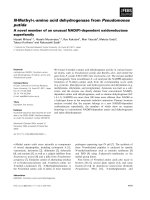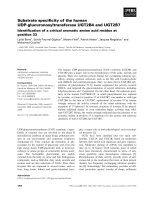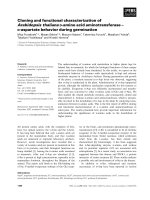Cu(II) and Ni(II) complexes of n (2 hydroxybenzyl) amino acid ligands synthesis, structures, properties and catecholase activity
Bạn đang xem bản rút gọn của tài liệu. Xem và tải ngay bản đầy đủ của tài liệu tại đây (1.2 MB, 82 trang )
Cu(II) AND Ni(II) COMPLEXES OF
N-(2-HYDROXYBENZYL)-AMINO ACID LIGANDS:
SYNTHESIS, STRUCTURES, PROPERTIES AND
CATECHOLASE ACTIVITY
BELLAM SREENIVASULU
(M. Sc., S. K. University, A. P. India)
A THESIS SUBMITTED
FOR THE DEGREE OF DOCTOR OF PHILOSOPHY
DEPARTMENT OF CHEMISTRY
NATIONAL UNIVERSITY OF SINGAPORE
2006
Dedicated to my beloved parents especially
To My Father
ACKNOWLEDGEMENTS
I am greatly indebted to my advisor, Dr. Jagadese J. Vittal for his invaluable
guidance, positive criticism, enlightening discussions and constructive suggestions
throughout the candidature which immensely helped me in attaining the scientific and
scholarly attitude of a researcher. I greatly admire his guidance and wish to express
my sincere gratitude for his constant support, patience and supervision at each and
every stage of my PhD life.
Many thanks to Prof. Song Gao, Peking University, China for low temperature
magnetic measurements and calculations. Also, many thanks to the all technicians and
staff from EA, NMR, IR, TGA, XRD, micro analytical, analytical and honours
laboratories at the Department of Chemistry, NUS. Particularly, I am thankful to Dr.
Jagadese J. Vittal for single crystal X-ray data collection, structure solution and
refinements of the crystal structures presented in this thesis.
I am grateful to my mother, brothers, sisters and all family members for their kind
support. Especially, I am thankful to my eldest brother, B. Ravi Kumar for his
guardianship, moral support and encouragement all the times. I also express my
sincere thanks to the past and present members of our research group and all my
friends who have shown their support for their invaluable and helpful discussions. I
am also thankful to Dr. Srinivasa Buddudu and Dr. W. Rajendra for their
encouragement.
I also deeply appreciate National University of Singapore for awarding me a
Research Fellowship for my PhD.
i
Declaration
This work described in this thesis was carried at the Department of
Chemistry, National University of Singapore from 7
th
Jan 2002 to 30
th
Mar
2006 under the supervision of Associate Professor Jagadese J. Vittal.
All the work described herein is my own, unless stated to the contrary, and
it has not been submitted previously for a degree at this or any other
university.
Bellam Sreenivasulu
2006
ii
Table of Contents
Acknowledgements i
Declaration ii
Table of Contents iii
Abbreviations x
Copyrights Permission xiv
Summary xv
List of Compounds Synthesized xviii
List of Figures xxvii
List of Tables xxxi
Publications and Presentations xxxiii
Chapter 1 Introduction
1-1 General Introduction 2
1-2 Coordination preferences of Cu and Ni 3
1-3 Copper(II) complexes of Schiff base ligands 4
1-4 Copper(II) complexes with reduced Schiff base ligands 11
1-5 Ni(II) complexes with Schiff base and reduced Schiff base ligands 15
1-6 Solid-state supramolecular transformations by thermal dehydration 18
1-7 Effect of C=O···π interactions on thermal dehydration 19
1-8 Supramolecular Isomerism 20
1-9 Ternary Cu(II) complexes: metal-ligand ratio and pH dependent reactivity 21
1-10 Effect of the chelating ability of the amino acid side arm of the ligands on
catecholase activity 23
1-11 Reduced Schiff base ligands containing 2-pyridinecarboxaldehyde 23
iii
1-12 Potential applications of Schiff base and reduced Schiff base complexes 28
1-13 Scope of the current investigation 30
1-14 References 34
Chapter 2
Dinuclear Copper(II) Complexes as Functional Models for the
Catechol Oxidase
2-1 Prelude to Parts A and B 48
Part-A Synthesis, Characterization, Structural Properties and
Catecholase Activity of Dicopper(II) Complexes of reduced
Schiff base Ligands
2-A-1 Introduction 61
2-A-2 Results and Discussion 61
2-A-2-1 Synthesis 61
2-A-2-2 Description of crystal structures 62
2-A-2-2-1 [Cu
2
(Scp11)
2
(MeOH)
2
], IIA-1a 64
2-A-2-2-2 [Cu
2
(ClScp11)
2
(DMF)(H
2
O)]. MeCN, IIA-2a 66
2-A-2-2-3 [Cu
2
(MeScp11)
2
(MeOH)
2
].2MeOH, IIA-3a 68
2-A-2-2-4 [Cu
2
(OHScp11)
2
(H
2
O)
2
], IIA-4 70
2-A-2-2-5 [Cu
2
(ClSch11)
2
(MeOH)
2
].2MeOH, IIA-6a 73
2-A-2-2-6 [{Cu
2
(Sch12)
2
}
2
⋅Cu
2
(Sch12)
2
(H
2
O)
2
].4H
2
O, IIA-8 75
2-A-2-2-7 [Cu
2
(ClSch12)
2
].2MeOH, IIA-9a 78
2-A-2-2-8 [Cu
2
(Diala4)
2
(DMSO)
2
]⋅2DMSO⋅2Acetone, IIA-12a 79
2-A-3 Physico-chemical studies 82
2-A-3-1 Infrared spectra 82
2-A-3-2 Electronic spectra 83
2-A-3-3 ESI-MS studies 85
iv
2-A-3-4 Thermogravimetric studies 87
2-A-3-5 Magnetic studies of [{Cu
2
(Sch12)
2
}
2
Cu
2
(Sch12)
2
(H
2
O)
2
].4H
2
O, IIA-8 89
2-A-4 Catecholase biomimetic studies 90
2-A-5 Summary 95
2-A-6 Experimental 96
2-A-6-1 Synthesis of ligands 96
2-A-6-2 Synthesis of complexes 102
2-A-6-3 Catecholase activity and kinetics measurements 107
2-A-6-4 X-ray crystallography 108
Part-B
Dicopper(II) Complexes as Functional Models for the Catecholase
Activity: Influence of Weakly Coordinating Sulfonate Group on
the Oxidation of 3,5-DTBC
2-B-1 Introduction 112
2-B-2 Results and discussion 113
2-B-2-1 Synthesis 113
2-B-2-2 Description of crystal structures 114
2-B-2-2-1 [Cu
2
(Sams)
2
(H
2
O)
2
], IIB-1 114
2-B-2-2-2 [Cu
2
(Saes)
2
(H
2
O)
2
].2H
2
O, IIB-3 116
2-B-2-2-3 [Cu
2
(Sae)
2
].2H
2
O, IIB-4 119
2-B-2-2-4 [Cu
2
(Sae)
2
(DMF)
2
].2DMF, IIB-5 122
2-B-3 Physico-chemical studies 124
2-B-3-1 Infrared spectra 124
2-B-3-2 Electronic spectra 125
2-B-3-3 Thermogravimetric studies 126
2-B-3-4 Magnetic properties of IIB-1, IIB-3 and IIB-4 127
v
2-B-4 Catecholase activity 129
2-B-5 Summary 133
2-B-6 Experimental 134
2-B-6-1 Preparation of ligands 134
2-B-6-2 Preparation of complexes 135
2-B-6-3 Catecholase activity and kinetics measurements 137
2-B-6-4 X-ray crystallography 137
2-B-7 References 140
Part-C
3D Coordination Polymer with Hexagonal Diamondoid Topology
displaying Star-like Channels
2-C-1 Introduction 150
2-C-2 Aim of the present investigation 151
2-C-3 Results and Discussion 151
2-C-3-1 Syntheses 151
2-C-3-2 Description of crystal structures 153
2-C-3-2-1 [Cu
2
(Scp11)
2
].H
2
O, IIC-1 153
2-C-3-2-2 [Cu
2
(Scp11)
2
(H
2
O)
2
]·2Me
2
CO, IIC-2 158
2-C-4 Physicochemical studies 160
2-C-4-1 Thermogravimetric studies 160
2-C-4-2 X-ray powder diffraction studies 161
2-C-5 Summary 163
2-C-6 Experimental 164
2-C-6-1 Synthesis of complexes 164
2-C-6-2 X-ray crystallography 165
2-C-7 References 167
vi
Part-D Experimental Section
2D-1 General 171
2D-2 NMR spectroscopy 171
2D-3 Infrared spectroscopy 171
2D-4 Electronic spectroscopy 171
2D-5 Optical Rotation 171
2D-6 Magnetic susceptibility measurements 172
2D-7 ESI-MS spectroscopy 172
2D-8 Elemental analysis 172
2D-9 Thermogravimetry 173
2D-10 X-ray powder diffraction 173
2D-11 Scanning Electron Microscopy 173
2D-12 Single crystal X-ray crystallography 173
2D-13 References 174
Chapter 3
Cu(II) and Ni(II) Complexes of reduced Schiff base Ligands
containing Additional Functional Groups in the Amino Acid side
chain
3-1 Introduction 176
3-2 Results and discussion 177
3-2-1 Description of crystal structures 178
3-2-1-1 [Cu(HSglu)(H
2
O)].H
2
O, III-2 178
3-2-1-2 [Cu(HMeSglu)(H
2
O)].2H
2
O, III-3 181
3-2-1-3 [Ni(HSas)(H
2
O)], III-5 185
3-2-1-4 [Ni
2
(Smet)
2
(H
2
O)
2
], III-6 188
vii
3-2-1-5 [Ni(HSapg)
2
], III-7 192
3-3 Physico-chemical studies 195
3-3-1 Infrared spectra 195
3-3-2 Electronic spectra 196
3-3-3 Thermogravimetric studies 197
3-4 Summary 198
3-5 Experimental 199
3-5-1 Synthesis of ligands 199
3-5-2 Synthesis of complexes 202
3-5-3 X-ray crystallography 204
3-6 References 206
Chapter 4 Ni(II) Helical Staircase Coordination Polymer Encapsulating
Helical Water Molecules
4-1 Introduction 210
4-2 Aim of the current investigation 213
4-3 Results and discussion 215
4-3-1 Crystal structure of [(H
2
O)
2
⊂{Ni(HSglu)(H
2
O)
2
}]⋅ H
2
O, IV-1 215
4-4 Physicochemical Studies 221
4-4-1 IR spectra 221
4-4-2 Electronic spectra 222
4-4-3 Thermogravimetric studies 222
4-5 Summary 224
4-6 Experimental 224
4-6-1 Synthesis of ligand 224
4-6-2 Synthesis of complex 225
viii
4-6-3 X-ray crystallography 225
4-7 References 227
Epilogue 231
Suggestions for Future work
236
Appendix (provided in the CD ROM attached)
A-1 Problem crystals S2
A-2 ESI-MS data of IIA-1– IIA-13 S4
A-3 Thermo gravimetric curves of IIA-1 – IIA-13 S7
A-4 UV-Vis spectra of oxidation of 3,5-DTBC by IIA-1 – IIA-13 S11
A-5 Lineweaver-Burk plots of IIA-1 – IIA-13 S13
A-6 Thermogravimetric curves of IIB-1 – IIB-4 S15
A-7 UV-Vis spectra of oxidation of 3,5-DTBC by IIB-2 and IIB-4 S16
A-8 Lineweaver-Burk plots of IIB-2 and IIB-4 S17
A-9 Thermo gravimetric curves of III-1 – III-7 S17
CIF files of all the crystal structures
ix
Abbreviations
Anal. Calcd. analysis calculated
2,2’-bpy 2,2’-bipyridine
4,4’-bpy 4,4’-bipyridine
BIP 1,3-bis[(4-methyl-5-imidazol-1-yl)ethyledeneamino]propane
BIPO 1,3-bis[(4-methyl-5-imidazol-1-yl)ethyledeneamino]propan-2-ol
CT charge transfer
d doublet
Decomp. decomposition
DMF dimethylformamide
DMSO dimethylsulfoxide
DTA differential thermal analysis
3,5-DTBC 3,5-di-tert-butylcatechol
3,5-DTBQ 3,5-di-tert-butylquinone
EPR electron paramagnetic resonance
e.s.d estimated standard deviation (standard uncertainty parameter)
ESI-MS electrospray ionization mass spectroscopy
ESR electron spin resonance
EtOH ethanol
Et
2
O diethyl ether
f.w formula weight
h hour
H
2
bbppnol N-(2-hydroxybenzyl)-N,N’,N’-tris(2-pyridylmethyl)-1,3-
diaminopropan-2-ol
Hbbpen 1,5-Bis(2-benzimidazoyl)-3-pentanol)
x
HBnZ
2
Salicylaldehyde semicarbazones
HSglym N-(2-hydroxybenzyl)-glycinamide
HSalam N-(2-hydroxybenzyl)-L-alaninamide
Hpala N-2(-pyridylmethyl)-L-alanine
Hpgly N-(2-pyridylmethyl)-glycine
Hpgly.HCl N-(2-pyridylmethyl)-glycine hydrocholoride
Hphis N-(2-pyridylmethyl)-L-histidine
H
2
Sa Salicylaldehyde acetylhydrazones
H
2
Sb Salicylaldehyde benzoylhydrazones
H
2
Salala N-salicylidene-L-alanine
H
2
Salgly N-salicylidene-glycine
H
2
Salphe N-salicylidene-L-phenylalanine
H
2
Sab4 N-(2-hydroxybenzyl)-4-aminobutyric acid
H
2
Sala N-(2-hydroxybenzyl)-L-alanine
H
2
ClSala N-(2-hydroxy-5-chlorobenzyl)-L-alanine
H
2
MeSala N-(2-hydroxy-5-methylbenzyl)-L-alanine
H
2
Sgly N-(2-hydroxybenzyl)-glycine
H
2
Shis N-(2-hydroxybenzyl)-L-histidine
H
2
Styr N-(2-hydroxybenzyl)-tyrosine
H
2
Sval N-(2-hydroxybenzyl)-L-valine
H
2
Stryp N-(2-hydroxybenzyl)-tryptophan
H
2
salen Bis(salicylidene) ethylenediamine
3-MeOsalen N,N’-ethylenebis(3-methoxysalicylideneaminato)
H
2
RScp11 N-(2-hydroxy-5-R-benzyl)-1-aminocyclopentatecarboxylic acid
H
2
Scp11 N-(2-hydroxybenzyl)-1-aminocyclopentatecarboxylic acid
xi
H
2
ClScp11 N-(2-hydroxy-5-chlorobenzyl)-1-aminocyclopentatecarboxylic acid
H
2
MeScp11 N-(2-hydroxy-5-methylbenzyl)-1-aminocyclopentatecarboxylic acid
H
2
OHScp11 N-(2,5-dihydroxybenzyl)-1-aminocyclopentatecarboxylic acid
H
2
RSch11 N-(2-hydroxy-5-R-benzyl)-1-aminocyclohexanecarboxylic acid
H
2
RSch12 N-(2-hydroxy-5-R-benzyl)-2-aminocyclohexanecarboxylic acid
H
2
Sch11 N-(2-hydroxybenzyl)-1-aminocyclohexanecarboxylic acid
H
2
ClSch11 N-(2-hydroxy-5-chlorobenzyl)-1-aminocyclohexanecarboxylic acid
H
2
MeSch11 N-(2-hydroxy-5-methylbenzyl)-1-aminocyclohexanecarboxylic acid
H
2
Sch12 N-(2-hydroxybenzyl)-2-aminocyclohexanecarboxylic acid
H
2
ClSch12 N-(2-hydroxy-5-chlorobenzyl)-2-aminocyclohexanecarboxylic acid
H
2
MeSch12 N-(2-hydroxy-5-methylbenzyl)-2-aminocyclohexanecarboxylic acid
H
3
Diala3 N-(2,3-dihydroxybenzyl)-L-alanine
H
3
Diala4 N-(2,4-dihydroxybenzyl)-L-alanine
H
3
Diala5 N-(2,5-dihydroxybenzyl)-L-alanine
H
2
Sams N-(2-hydroxysalicylidene)-aminomethanesulfonic acid
H
2
Saes N-(2-hydroxysalicylidene)-aminoethanesulfonic acid
H
2
Sam N-(2-hydroxybenzyl)-aminomethanesulfonic acid
H
2
Sae N-(2-hydroxybenzyl)-aminoethanesulfonic acid
H
2
Sas N -(2-hydroxybenzyl)-L-aspartic acid
H
3
Sglu N -(2-hydroxybenzyl)-L-glutamic acid
H
3
MeSglu N-(2-hydroxy-5-methylbenzyl)-L-glutamic acid
H
2
Smet N-(2-hydroxybenzyl)-L-methionine
H
2
Sapg N-(2-hydroxybenzyl)-L-aspargine
H
2
Sbal N-(2-hydroxybenzyl)-β-alanine/N-(2-hydroxybenzyl)-3-amino-
propanoic acid
xii
Hz hertz
Ind. Reflns independent reflections
IR infra red
J
A-B
coupling constant between nuclei A and B
LMCT ligand to metal charge transfer
m multiplet
Max maximum
MeOH methanol
MeCN acetonitrile
Min minimum
mp melting point
NMR nuclear magnetic resonance
phen 1,10-phenanthroline
PLP Pyridoxal phosphate
Reflns. col. reflections collected
s singlet
SEM scanning electron microscopy
SP square pyramidal
t triplet
TBP trigonal bipyramidal
TGA thermogravimetric analysis
TMS tetramethylsilane
UV-vis ultraviolet-visible
VT variable temperature
XRPD X-ray powder diffraction
xiii
Copyrights Permission
I sincerely acknowledge the publishers of American Chemical Society (ACS), Wiley-
VCH Verlag GmbH & Co KG, Royal Society of Chemistry (RSC) and Elsevier B. V
(ScienceDirect) for granting copyrights permission to reproduce the figures from the
respective journals as below. Permission has been granted for using the following list
of figures from various journals of the above mentioned publishers (citations have
also been mentioned in the figure captions appropriately).
Copyrights permission from American Chemical Society
Figure 1-9. Reprinted with permission from Inorg. Chem. 2005, 44, 1302.
Figure 1-12. Reprinted with permission from Cryst. Growth Des. 2005, 5, 41.
Figure 1-13. Reprinted with permission from Cryst. Growth Des. 2004, 3, 781.
Figure 1-14. Reprinted with permission from Inorg. Chem. 2001, 40, 5934.
Figure 2-2. Reprinted with permission from Acc. Chem. Res. 2002, 35, 183.
Figure 2-4. Reprinted with permission from Acc. Chem. Res. 2002, 35, 183.
Figure 2-6. Reprinted with permission from Inorg. Chem. 1996, 35, 3409.
Figure 2-11. Reprinted with permission from Inorg. Chem. 2002, 41, 1788.
Figure 2-12. Reprinted with permission from Inorg. Chem. 2002, 41, 3983.
Copyrights permission from Wiley-VCH Verlag GmbH & Co KG
Figure 1-2. Taken from Angew.Chem. Int. Ed. Engl. 2004, 43, 87.
Figure 1-8. Taken from Angew. Chem. Int. Ed. Engl. 2003, 42, 1940.
Figure 2-8. Taken from Chem. Eur. J. 2002, 8, 247.
Figure 2-9 (right).Taken from Chem. Eur. J. 2001, 7, 2143.
Figure 2-10. Taken from Chem. Eur. J. 2001, 7, 2143.
Figure 4-1. Taken from Angew.Chem. Int. Ed. Engl. 2005, 44, 5720.
Figure 4-3. Taken from Eur. J. Inorg. Chem. 2005, 3214.
Copyrights permission from Royal Society of Chemistry
Figure 4-2. Chem. Commun. 2004, 716 (Reprinted with permission of The Royal
Society of Chemistry)
Figure 4-4. Chem. Commun. 2005, 3024 (Reprinted with permission of The Royal
Society of Chemistry)
Copyrights permission from Elsevier B.V. (ScienceDirect)
Figure 2-9 (left). Taken from Inorg. Chim. Acta 2002, 337, 429
xiv
Summary
This research work presents the synthesis, characterization and structural studies of
different series of Cu(II) and Ni(II) complexes of N-(2-hydroxy-5-substituted-benzyl)-
amino acids which includes various natural/unnatural amino acids. The unnatural
amino acids employed to synthesize these ligands are
aminocyclopentane/hexanecarboxylic acids and aminomethane/ethanesulfonic acids
containing carboxylate and sulfonate donors respectively. The objective of the present
study is to investigate the coordination chemistry of these ligands with Cu(II) and
Ni(II) and explore the Cu(II) complexes as functional models for the enzyme,
catechol oxidase.
While utilizing the unnatural amino acids such as 1- and/or 2-
aminoclopentane/hexanecarboxylic acids, and commercially available
salicylaldehydes with para-substituents such as H, Me, Cl and OH, various reduced
Schiff base ligands, N-(2-hydroxy-5-substituted-benzyl)-amino acids are synthesized.
On the other hand, commercially available L-alanine and different hydroxy
substituted salicylaldehydes are utilized for the synthesis of 3-, 4- and 5- hydroxy
substituted N-(2-hydroxybenzyl)-L-alanine ligands. A new series of closely related yet
distinct dinuclear Cu(II) complexes, obtained upon subsequent complexation with all
these ligands, are investigated for their structural properties and for their ability to
mimic catechol oxidase as functional models. These activity studies are mainly
focused on evaluating the effect of various substituents such as OH, Cl and –CH
3
,
present at the 5
th
position of the phenyl ring of the ligands on the oxidation of 3,5-
DTBC (catecholase activity). A detailed account of these findings is given in Part-A
in Chapter 2. Further, the catecholase activities observed in these complexes, under
xv
the similar experimental conditions, are compared with that of the related dicopper(II)
complexes previously studied by our research group.
Another series of dicopper(II) complexes of the reduced Schiff base ligands, N-(2-
hydroxybenzyl)-aminomethane/ethanesulfonic acids, containing weakly coordinating
sulfonate donor group instead of carboxylate group in the amino acid side arm are
investigated to evaluate the role of sulfonate donor on the structures as well as on
catecholase activity. In this case the Schiff base complexes are also studied. These
results demonstrating the effect of weakly coordinating sulfonate donors on both the
structures and catecholase activity are also systematically compared with the related
and analogous complexes containing carboxylate donors. Details of these findings are
given as Part-B in Chapter 2.
The reactivity of H
2
Scp11 ligand towards Cu(II) ion under different crystallization
conditions and the interesting structural features of the resulting Cu(II) complexes are
presented in Part-C in Chapter 2.
Further investigations on the coordination chemistry of reduced Schiff base ligands
are made by incorporating additional reactive functional groups in the amino acid side
arm such as –COO
-
, -SCH
3
, -CONH
2
with a view that these additional functional
groups may show interesting connectivity upon complexation with metal ions such as
Cu(II) and Ni(II). The results are described in Chapter 3.
xvi
A Ni(II) complex of H
3
Sglu (N-(2-hydroxybenzyl)-L-glutamic acid) ligand, with a
novel display of spiral coordination polymeric structure with a fascinating
encapsulation of hydrogen bonded helical water molecules is described in Chapter 4.
xvii
List of Compounds Synthesized
Code
Name and Formula
Structure
H
2
RScp11
N-(2-hydroxy-5-R-benzyl)-1-amino
cyclopentanecarboxylic acid,
(R = H, Cl, Me, OH)
IIA-1
[Cu
2
(Scp11)
2
(H
2
O)
2
]
IIA-1a
[Cu(Scp11)
2
(MeOH)
2
]*
IIA-2
[Cu
2
(ClScp11)
2
(H
2
O)
2
]
xviii
IIA-2a
[Cu
2
(ClScp11)
2
(DMF)(H
2
O)].MeCN*
IIA-3
[Cu
2
(MeScp11)
2
(H
2
O)
2
]
IIA-3a
[Cu
2
(MeScp11)
2
(MeOH)
2
].2MeOH*
IIA-4
[Cu
2
(OHScp11)
2
(H
2
O)
2
]*
xix
H
2
RSch11
N-(2-hydroxy-5-R-benzyl)-1-amino
cyclohexanecarboxylic acid
(R = H, Cl, Me)
IIA-5
[Cu
2
(Sch11)
2
].(H
2
O)
IIA-6
[Cu
2
(ClSch11)
2
(H
2
O)
2
]
IIA-6a
[Cu
2
(ClSch11)
2
(MeOH)
2
].2MeOH*
IIA-7
[Cu
2
(MeSch11)
2
(H
2
O)
2
]
xx
H
2
RSch12
N-(2-hydroxy-5-R-benzyl)-2-amino
cyclohexanecarboxylic acid
(R = H, Cl, Me)
IIA-8
[{Cu
2
(Sch12)
2
}
2
Cu
2
(Sch12)
2
(H
2
O)
2
].4H
2
O*
IIA-9
[Cu
2
(ClSch12)
2
].2H
2
O
IIA-9a
[Cu
2
(ClSch12)
2
].2MeOH*
IIA-10
[Cu
2
(MeSch12)
2
(H
2
O)
2
]
xxi
H
3
Diala3
N-(2,3-dihydroxybenzyl)-L-alanine
H
3
Diala4
N-(2,4-dihydroxybenzyl)-L-alanine
H
3
Diala5
N-(2,5-dihydroxybenzyl)-L-alanine
IIA-11
[Cu
2
(Diala5)
2
(H
2
O)
2
].H
2
O
IIA-12
[Cu
2
(Diala4)
2
(H
2
O)
2
].H
2
O
IIA-12a
[Cu
2
(Diala4)
2
(DMSO)
2
]⋅2DMSO⋅2Acetone*
xxii
IIA-13
[Cu
2
(Diala3
)
2
(H
2
O)
2
].H
2
O
H
2
Sams
N-(2-hydroxysalicylidene)
aminomethanesulfonic acid
H
2
Sam
N-(2-hydroxybenzyl)-amino
methanesulfonic acid
H
2
Saes
N-(2-hydroxysalicylidene)-amino
ethanesulfonic acid
H
2
Sae
N-(2-hydroxybenzyl)-amino
ethanesulfonic acid
IIB-1
[Cu
2
(Sams)
2
(H
2
O)
2
]*
IIB-2
[Cu
2
(Sam)
2
(H
2
O)
2
].H
2
O
xxiii









